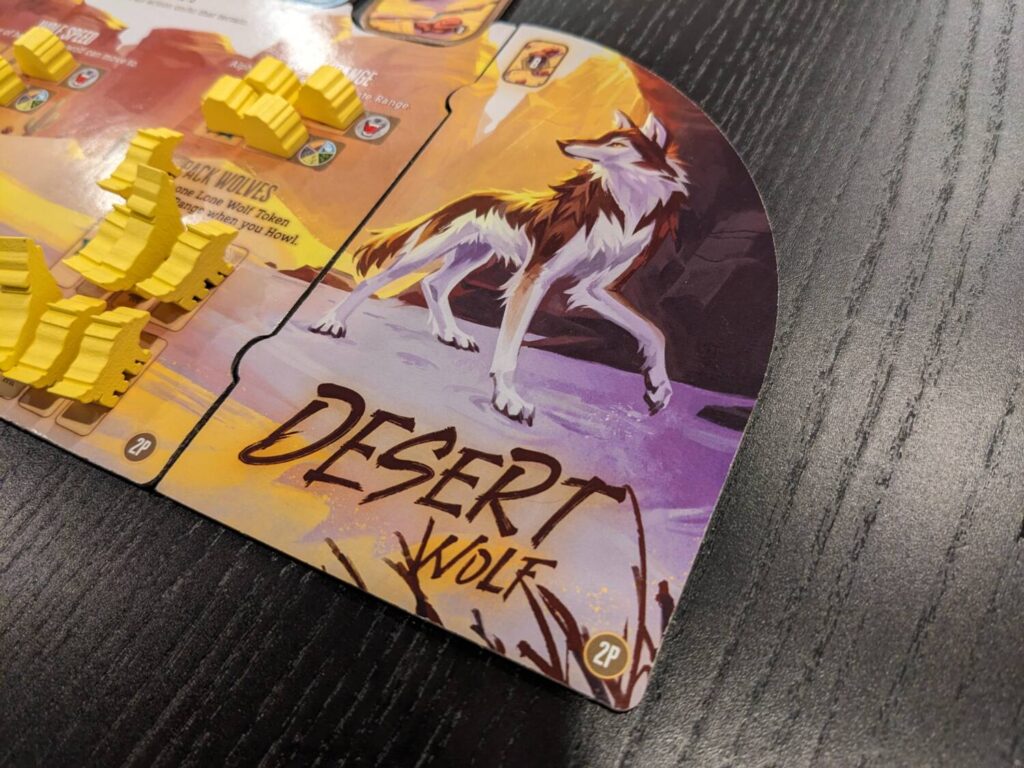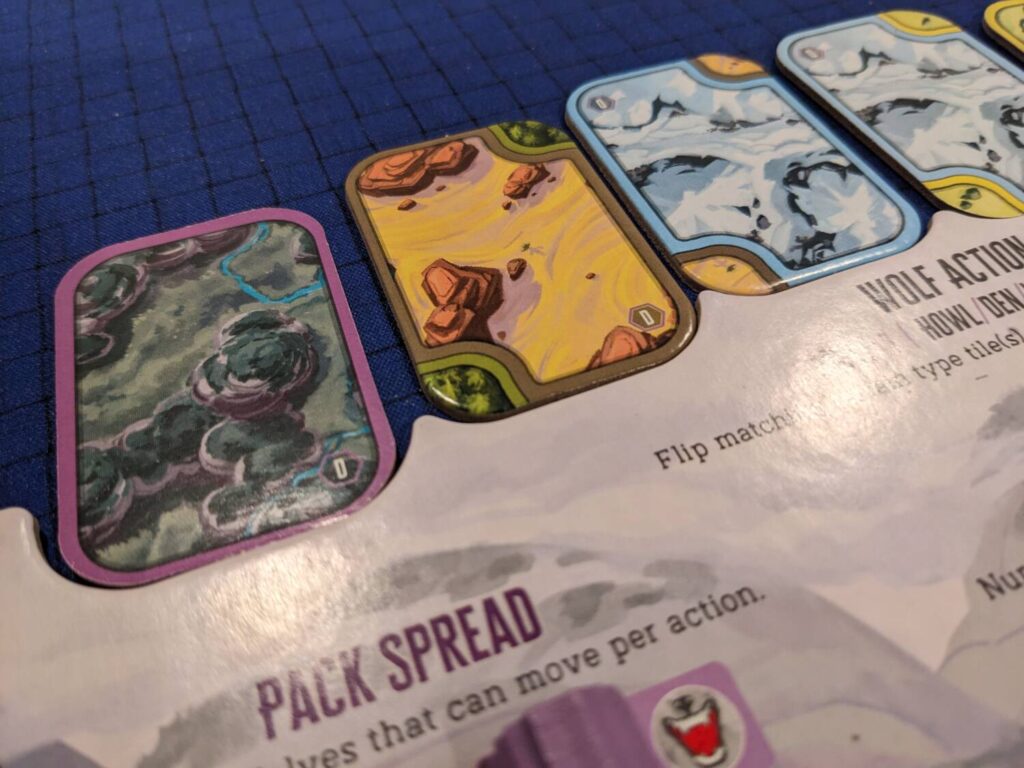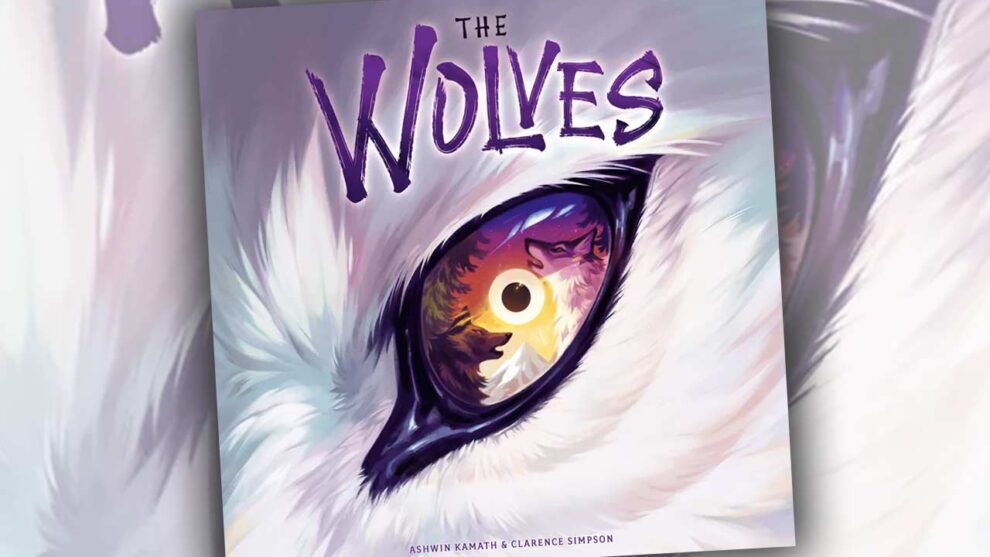Disclosure: Meeple Mountain received a free copy of this product in exchange for an honest, unbiased review. This review is not intended to be an endorsement.
I was a little worried when I pulled The Wolves off the shelf. That’s because The Wolves is published by Pandasaurus Games, who recently released Roller Coaster Rush, one of the worst, if not THE worst, games I’ve played this year.
I’m happy to share that The Wolves put things back on track.
I love area control games, I love great production, and I love games that play in about an hour. After watching a short 10-minute teach video, my review crew was up and running and had the chance to get The Wolves to the table.
It’s not perfect, but it is clever. In fact, I was surprised how many times players have used the word “clever” to describe their experience with The Wolves, and I have to agree.

Clever
The Wolves is an area control game for 2-5 players that plays in about an hour, maybe 75 minutes. The game is round-less, meaning that once play begins, players take turns until the end-game trigger is pulled. In the case of The Wolves, that happens when the third mid-game scoring round takes place.
The action selection system here is, yes, clever. Each player board has six double-sided tiles—one is double-sided with the same terrain type, aligned with the wolf pack of that color/shade/territory preference. (For example, Rocky Wolf has a tile with mountains on both sides.) The other five double-sided tiles represent two instances of each of the five terrain types, but each tile has two different terrains.
When players take each of their two actions per turn, they have to pay a cost by flipping over a number of tiles equal to that action’s cost. If you want to move to a desert hex with a couple of your wolfpack members, all good—just flip one tile showing the target destination, then move a certain number of spaces. Want to build a lair, which converts a den on the map? Just flip two tiles matching the new lair’s terrain type.
And then, flipping those tiles creates other opportunities. Wild terrain tokens allow players to spend bonuses earned earlier in the game to skip flipping a tile, burning that token instead. Setting up moves is fun too, because each tile shows a small reminder in each corner of what terrain is on the back of a tile, so I found myself constantly thinking about how to do something productive on my first turn so that I could do something massive on my second, or vice versa.
The cost of actions in The Wolves is really clever, and it avoids the normal resource collection needed in games like this while also keeping the system really clean. This action selection mechanism is the best part of the game.

Cleverer
I mentioned Roller Coaster Rush earlier. That game was the only time I’ve played a Pandasaurus production that had terrible components.
The Wolves is traditional Pandasaurus fare…which means the production is both outstanding and clever. (It’s also clever.)
I love the wolf pieces. Wolves come in two flavors—pack wolves are smaller, and Alpha wolves are larger and seem to be howling at the moon. Even from across the table, it’s always very easy to tell which wolves are which, and the five available player colors feel distinct enough from each other.
The lair pieces are my favorite. I didn’t notice this until the end of my first play, but there’s an outline of a wolf’s head that makes up the entryway of each lair component. Sure, it’s a game called The Wolves with wolf pieces everywhere, but to add even one more wolf reference is just really funny. And clever.
The rulebook is great (my copy had a note about an error on page 13, so even that was accounted for in this second printing of the game), but the player aid is even better. Although my group uses teach videos to learn games when possible, a person could teach the entire game from the double-side player aid and be all set. On at least three occasions during my first play, players had questions that were answered by the fine print of the player aid.
All games need player aids, and The Wolves knocks it out of the park on the player aid front.
The player boards bring all of this home for me, though. I adore these boards. There’s space for my flippable action tiles. The cost of each action is clearly labeled near the top of the player board. The board doesn’t take up a lot of space. Points that can be uncovered then scored are easy to see, everything has a place, and nothing is too cluttered. This is quite possibly the gold standard for what I want out of a player board, without even needing the glitz of inset spaces carved out for components, tracks, or being triple-layered or anything else silly. It’s a place to hold my stuff, and to support the player aid. Beautiful!
Now, the production isn’t perfect. I wish the markers that call out which regions are going to be scored next were wooden, or maybe flag standees, or different colors. It’s somewhat easy to tell which regions are active, and that gets easier as the game goes along because previously-scored region bonus tokens are taken off of the map.
Also, I’m torn on the calendar board, used to track when mid-game scoring will take place. Players were sometimes looking ahead at a marker that wasn’t accurate, because the calendar has both four- and five-player milestones listed on one side, with two- and three-player milestones on the other. In a four-player game, you need to pay attention to the small “4P” spots, not the “5P” spots, but they all sit together on the same calendar.

Cleverer…er
The Wolves does something fun with its area control mechanics that I really enjoyed—it allows for players to run or walk towards each scoring round.
The game’s timer is tied to replacing pieces on the map. If a player uses an Alpha wolf to “dominate” another player’s pack wolf, they replace that wolf with one from their player board, and stick the old wolf on a day of the calendar. This pace can be hard to predict, making everyone push to gain control of a region that is about to score because that scoring might happen sooner than you want!
This also means that in each game of The Wolves, players have a chance for clever play by trying to take control of a region while also triggering a mid-game scoring. This is consistently a blast—how do I sneak in and take an area, or even the second-place reward for having presence in a region, by making a move that also means no one can combat it?
In other cases, I have found myself NOT adding pieces to the calendar, simply to give myself more time to run all over the place and set myself up for a few points. Pacing in The Wolves is a tug-of-war, and I like the lack of predictability that goes along with it. I’ve seen this in other games (such as Cerebria: The Inside World), but in The Wolves the rules overhead is significantly lower.

Cleverest
Here’s the best part: The Wolves is a year old, which in gaming terms is at least a generation. That means you can find a copy of this game online for less than $40, and if you like area control games, you should do just that.
The Wolves is plain ol’ fun. All players have chances to make an impact, the action selection is great, the game is short for a strategy game, and the production is top notch. I don’t know if this is the kind of game I’ll play 30 times, but your first five plays are going to be interesting and each journey will be a bit unique.
There are a scattering of minor issues I’ve had with gameplay. The map feels a bit too large for me (regardless of player count), as I enjoy area control games where the maps really require everyone to be in every other player’s way. Two-player area control games are usually not interesting to me, and while The Wolves has a two-player variant, that’s not the reason I would buy this game. (My wife and I enjoyed it, but both complained that the dummy player’s components just sit in one spot on each tile for the entire game. Not very interesting.)
As a go-for-broke area control game with a great pace, I haven’t played many games as good as The Wolves this year. Give it a look!












